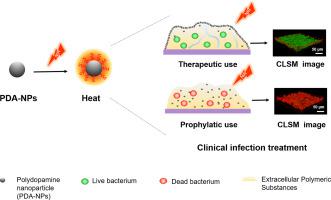Nanomedicine: Nanotechnology, Biology and Medicine ( IF 5.4 ) Pub Date : 2020-11-10 , DOI: 10.1016/j.nano.2020.102324 Ruifang Gao 1 , Henny C van der Mei 2 , Yijin Ren 3 , Hong Chen 4 , Gaojian Chen 4 , Henk J Busscher 2 , Brandon W Peterson 2

|
Nanotechnology offers many novel infection-control strategies that may help prevent and treat antimicrobial-resistant bacterial infections. Here, we synthesized polydopamine, photothermal-nanoparticles (PDA-NPs) without further surface-functionalization to evaluate their potential with respect to biofilm-control. Most ESKAPE-panel pathogens in suspension with photothermal-nanoparticles showed three- to four-log-unit reductions upon Near-Infra-Red (NIR)-irradiation, but for enterococci only less than two-log unit reduction was observed. Exposure of existing Staphylococcus aureus biofilms to photothermal-nanoparticles followed by NIR-irradiation did not significantly kill biofilm-inhabitants. This indicates that the biofilm mode of growth poses a barrier to penetration of photothermal-nanoparticles, yielding dissipation of heat to the biofilm-surrounding rather than in its interior. Staphylococcal biofilm-growth in the presence of photothermal-nanoparticles could be significantly prevented after NIR-irradiation because PDA-NPs were incorporated in the biofilm and heat dissipated inside it. Thus, unmodified photothermal nanoparticles have potential for prophylactic infection-control, but data also constitute a warning for possible development of thermo-resistance in infectious pathogens.
中文翻译:

ESKAPE 面板病原体的耐热性,通过光热、聚多巴胺纳米颗粒在体外根除和防止传染性生物膜的生长
纳米技术提供了许多可能有助于预防和治疗抗微生物细菌感染的新型感染控制策略。在这里,我们在没有进一步表面功能化的情况下合成了聚多巴胺、光热纳米颗粒 (PDA-NPs),以评估它们在生物膜控制方面的潜力。大多数带有光热纳米颗粒的 ESKAPE 面板病原体在近红外 (NIR) 照射下显示出三到四个对数单位减少,但对于肠球菌,仅观察到不到两个对数单位减少。暴露现有金黄色葡萄球菌将生物膜转化为光热纳米颗粒,然后进行近红外辐射并没有显着杀死生物膜居民。这表明生物膜的生长模式对光热纳米颗粒的渗透构成了障碍,使热量散发到生物膜周围而不是其内部。在近红外辐射后,可以显着防止在光热纳米颗粒存在下葡萄球菌生物膜的生长,因为 PDA-NPs 被纳入生物膜并在其中散发热量。因此,未经修饰的光热纳米粒子具有预防性感染控制的潜力,但数据也构成了对传染性病原体可能产生耐热性的警告。



























 京公网安备 11010802027423号
京公网安备 11010802027423号